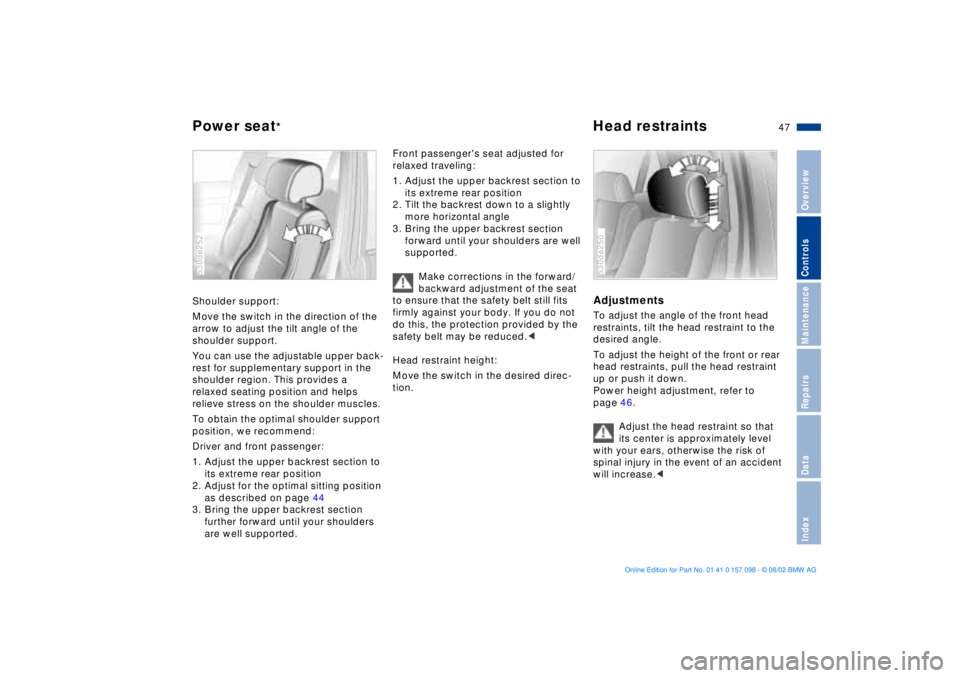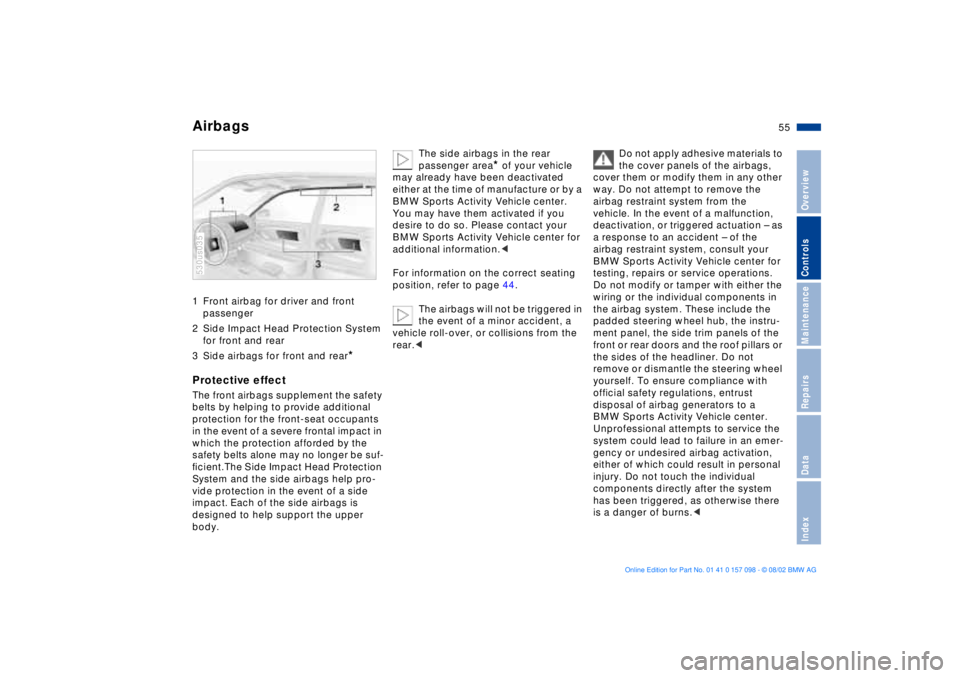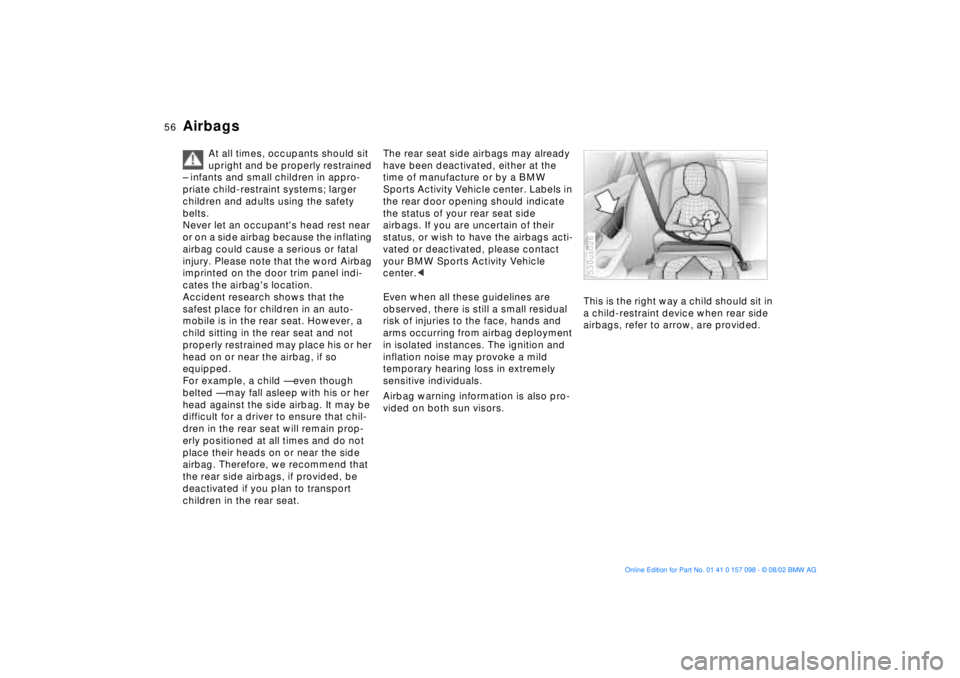2003 BMW X5 4.6IS belt
[x] Cancel search: beltPage 4 of 183

Contents
© 2002 Bayerische Motoren Werke
Aktiengesellschaft
Munich, Germany
Reprinting, including excerpts, only with the
written consent of BMW AG, Munich.
Order No. 01 41 0 157 098
US English IX/2002
Printed in Germany
Printed on environmentally friendly paper Ð
bleached without chlorine, suitable for recycling.
Notes
Overview
Controls and features
About this Owner's Manual 8
Symbols used 8
The individual vehicle 8
Status at time of printing 9
For your own safety 9
Symbol on vehicle parts 10
Service and Warranty 10
Reporting safety defects 10Cockpit
14
Instrument cluster 15
Indicator and warning lamps 19
Steering wheel with multifunction buttons 23
Warning triangle 24
First-aid kit 24
Refueling 24
Fuel specifications 26
Tire inflation pressures 26
Locks and security systems:
Keys30
Central locking system 30
Opening and closing Ð via the remote control 31
Opening and closing Ð via the door lock 34
Opening and closing Ð from the inside 35
Liftgate 36
Tailgate 37
Alarm system 39
Electric power windows 40
Sliding/tilt sunroof with glass moonroof 42
Adjustments:
Safe seating position 44
Seats 44
Mechanical seat 45
Power seat 46
Head restraints 47
Power rear-seat backrest adjustment 48
Safety belts 49
Seat, mirror and steering wheel
memory 50
Seat heating 51
Steering wheel 52
Steering wheel heating 53
Mirrors 53
Inhalt
Page 19 of 183

19n
OverviewControlsMaintenanceRepairsDataIndex
Indicator and warning lamps
Technology that monitors itself
Indicator and warning lamps that are
identified by
l
are tested for proper
functioning whenever the ignition key is
turned. They each light up once for
different periods of time.
If a fault should occur in one of these
systems, the corresponding lamp does
not go out after the engine is started or
it lights up while the vehicle is moving.
You will see how to react to this in the
following section.
Red: stop immediately
Battery charge current
l
The battery is no longer being
charged. There is a malfunction
of the alternator drive belt or in the
charging circuit of the alternator. Please
contact the nearest BMW Sports
Activity Vehicle center.
If the drive belt is defective, do not
continue driving. The engine could
be damaged due to overheating. If the
drive belt is defective, increased
steering effort is also required.
<
Engine oil pressure
l
Stop the vehicle immediately
and switch off the engine.
Check the engine oil level; top off as
required. If the oil level is correct:
please contact the nearest BMW Sports
Activity Vehicle center.
Do not continue driving. The
engine could be damaged
because of inadequate lubrication.
<
Parking brake
*
/
Brake hydraulic system
l
Comes on when you engage the
parking brake.
For additional information: refer to
page 64.
Comes on although the parking brake
is released: have the brake fluid level
checked. Before continuing your
journey, be sure to read the notes on
pages 132 and 144.
Also comes on in the Check Control
with the message CHECK BRAKE
LININGS.
Parking brake warning lamp
*
/
Brake hydraulic system warning
lamp for Canadian models.
Tire Pressure Monitor RDC
*
l
In addition, an acoustic signal is
sounded: a flat tire has
occurred. Reduce vehicle speed imme-
diately and stop the vehicle. Avoid hard
brake applications. As you steer the
vehicle, use caution and avoid overcor-
recting.
For additional information: refer to
page 96.
Page 20 of 183

20n
Indicator and warning lamps
Red or yellow: continue to drive;
drive cautiously
If the brake warning lamp
comes on red together with the
yellow warning lamps for ABS
and DSC:
Continue to drive; drive
cautiously and defensively and
avoid full brake applications.
Have the system checked by the
nearest BMW Sports Activity Vehicle
center.
For additional information: refer to
pages 91 and 132.
If all three warning lamps come on
yellow:
Continue to drive; drive cautiously and
defensively and avoid full brake appli-
cations.
Have the system checked by your
BMW Sports Activity Vehicle center as
soon as possible.
Warning lamps for Canadian
models.
Red: an important reminder
Parking brake
*
Comes on when the parking
brake is engaged.
For additional information: refer to
page 64.
Parking brake
*
warning lamp
for
Canadian models.
Please fasten safety belts
l
Lights up either for a few
seconds or, depending on
model, until the belt is engaged.
Depending on model, together with an
acoustic signal
*
or a message
*
in the
Check Control.
For additional information on safety
belts: refer to page 49.
Airbags
l
Please have the system
inspected by your BMW Sports
Activity Vehicle center.
For additional information: refer to
page 55.
Yellow: check as soon as possible
Antilock Brake System ABS
l
ABS has been deactivated in
response to system malfunction.
Conventional braking performance
remains available with no loss of effi-
ciency. Please have the system
inspected by your BMW Sports Activity
Vehicle center.
For additional information: refer to
page 132.
ABS warning lamp for Canadian
models.
Engine oil level
Comes on while driving:
The oil level is at the absolute
minimum; refill as soon as possible. Do
not drive more than approx. 30 miles/
50 km until you do.
For additional information: refer to
page 141.
Engine oil level
Comes on after the engine has
been switched off: add engine
oil at your earliest opportunity, e.g.
when you stop to refuel.
For additional information: refer to
page 141.
Page 44 of 183

44n
The condition for relaxed, fatigue-free
driving is a seating position adjusted to
your needs. Together with the safety
belts and the airbags, the seating posi-
tion is very important for the passive
safety of the occupants in the case of
an accident. Therefore, observe the
following instructions, as otherwise the
protective function of the safety
systems may be impaired.
For additional information on trans-
porting children safely, refer to
page 58.
Sitting safely with airbags
Maintain a distance to the airbags.
Always hold the steering wheel by
the rim with the hands at the 9 and
3-o'clock positions to keep any chance
of injury to hands or arms to an abso-
lute minimum, should the airbag be
deployed. No one and nothing is to
come between the airbags and the seat
occupant. Do not use the cover of the
front airbag on the front passenger side
as a storage area for objects, or as a
rest for feet or legs.<
For the location of the airbags and
additional information, refer to page 55.
Sitting safely with safety belts
Never allow more than one person
to wear a single safety belt. Never
allow infants or small children to ride in
a passenger's lap. Avoid twisting the
belt while routing it firmly across the
pelvis and shoulder, wear it as snugly
against your body as possible. Do not
allow the belt to rest against hard or
fragile objects in your pockets. Never
route the belt across your neck, do not
run it across sharp edges and ensure
that the belt does not become caught
or jammed. Avoid wearing bulky
clothing and pull on the lap belt periodi-
cally to retension it over your shoulders.
In the event of a frontal impact, a loose
lap belt could slide over your hips,
leading to abdominal injury. In addition,
the safety belt's restraint effectiveness
is reduced if the belt is worn loosely.
Expectant mothers should always wear
their safety belts, taking care to position
the lap belt against the lower hips,
where it will not exert pressure against
the abdominal area.<
For instructions on operating the safety
belts, refer to page 49.
Observe the following before
adjusting
Never try to adjust your seat while
operating the vehicle. The seat
could respond with unexpected move-
ment, and the ensuing loss of vehicle
control could lead to an accident. Never
ride with the backrest reclined to an
extreme horizontal angle Ð especially
important for front passengers to
remember.
If you do so there is a risk that you will
slide under the safety belt in an acci-
dent, thus reducing the protection
provided by the safety belt
.<
Seat adjustment>Mechanical seat adjustment, refer to
page 45
>Power seat adjustment, refer to
page 46
>Head restraints, refer to page 47
>Power rear-seat backrest adjustment,
refer to page 48
Safe seating position Seats
Page 47 of 183

47n
OverviewControlsMaintenanceRepairsDataIndex
Power seat
*
Head restraints
Shoulder support:
Move the switch in the direction of the
arrow to adjust the tilt angle of the
shoulder support.
You can use the adjustable upper back-
rest for supplementary support in the
shoulder region. This provides a
relaxed seating position and helps
relieve stress on the shoulder muscles.
To obtain the optimal shoulder support
position, we recommend:
Driver and front passenger:
1. Adjust the upper backrest section to
its extreme rear position
2. Adjust for the optimal sitting position
as described on page 44
3. Bring the upper backrest section
further forward until your shoulders
are well supported.530de252
Front passenger's seat adjusted for
relaxed traveling:
1. Adjust the upper backrest section to
its extreme rear position
2. Tilt the backrest down to a slightly
more horizontal angle
3. Bring the upper backrest section
forward until your shoulders are well
supported.
Make corrections in the forward/
backward adjustment of the seat
to ensure that the safety belt still fits
firmly against your body. If you do not
do this, the protection provided by the
safety belt may be reduced.<
Head restraint height:
Move the switch in the desired direc-
tion.
Adjustments To adjust the angle of the front head
restraints, tilt the head restraint to the
desired angle.
To adjust the height of the front or rear
head restraints, pull the head restraint
up or push it down.
Power height adjustment, refer to
page 46.
Adjust the head restraint so that
its center is approximately level
with your ears, otherwise the risk of
spinal injury in the event of an accident
will increase.< 530de250
Page 49 of 183

49n
OverviewControlsMaintenanceRepairsDataIndex
Safety beltsDrive with your safety belt on Even though there is an airbag, wear a
safety belt every time you get in the
vehicle, because airbags enhance
safety by providing added protection.To lockMake sure you hear the lock engage in
the belt buckle.
Please fasten safety belts
warning lamp
Lights up either for a few
seconds or until the belt is engaged.To unlock1. Press the red button in the buckle
2. Hold the belt
3. Guide the belt back into its reel.530us034
In the rear, the belt buckle with
the word CENTER is intended
exclusively for passengers sitting in the
middle.
If it is not possible to extract the center
belt, this indicates that the larger back-
rest is not securely locked, refer to
page 120.<
Safety belt height adjustmentYou can adjust the safety belts to fit
your own physical dimensions by using
the safety belt height adjustment:
Slide the button up or down as
required.
Also observe the instructions on
adjusting the seats on page 44.
If the safety belt system has been
subjected to the stresses involved
in an accident or otherwise damaged:
Have the entire safety belt system
replaced by your BMW Sports Activity
Vehicle center. In addition, have your
BMW Sports Activity Vehicle center
inspect the safety belt anchors. Other-
wise, the safety function can no longer
be ensured.c530de259
Page 55 of 183

55n
OverviewControlsMaintenanceRepairsDataIndex
Airbags1 Front airbag for driver and front
passenger
2 Side Impact Head Protection System
for front and rear
3 Side airbags for front and rear
*
Protective effectThe front airbags supplement the safety
belts by helping to provide additional
protection for the front-seat occupants
in the event of a severe frontal impact in
which the protection afforded by the
safety belts alone may no longer be suf-
Þcient. The Side Impact Head Protection
System and the side airbags help pro-
vide protection in the event of a side
impact. Each of the side airbags is
designed to help support the upper
body. 530us035
The side airbags in the rear
passenger area
* of your vehicle
may already have been deactivated
either at the time of manufacture or by a
BMW Sports Activity Vehicle center.
You may have them activated if you
desire to do so. Please contact your
BMW Sports Activity Vehicle center for
additional information.<
For information on the correct seating
position, refer to page 44.
The airbags will not be triggered in
the event of a minor accident, a
vehicle roll-over, or collisions from the
rear.<
Do not apply adhesive materials to
the cover panels of the airbags,
cover them or modify them in any other
way. Do not attempt to remove the
airbag restraint system from the
vehicle. In the event of a malfunction,
deactivation, or triggered actuation Ð as
a response to an accident Ð of the
airbag restraint system, consult your
BMW Sports Activity Vehicle center for
testing, repairs or service operations.
Do not modify or tamper with either the
wiring or the individual components in
the airbag system. These include the
padded steering wheel hub, the instru-
ment panel, the side trim panels of the
front or rear doors and the roof pillars or
the sides of the headliner. Do not
remove or dismantle the steering wheel
yourself. To ensure compliance with
official safety regulations, entrust
disposal of airbag generators to a
BMW Sports Activity Vehicle center.
Unprofessional attempts to service the
system could lead to failure in an emer-
gency or undesired airbag activation,
either of which could result in personal
injury. Do not touch the individual
components directly after the system
has been triggered, as otherwise there
is a danger of burns.<
Page 56 of 183

56n
Airbags
At all times, occupants should sit
upright and be properly restrained
Ð infants and small children in appro-
priate child-restraint systems; larger
children and adults using the safety
belts.
Never let an occupant's head rest near
or on a side airbag because the inflating
airbag could cause a serious or fatal
injury. Please note that the word Airbag
imprinted on the door trim panel indi-
cates the airbag's location.
Accident research shows that the
safest place for children in an auto-
mobile is in the rear seat. However, a
child sitting in the rear seat and not
properly restrained may place his or her
head on or near the airbag, if so
equipped.
For example, a child Ñ even though
belted Ñ may fall asleep with his or her
head against the side airbag. It may be
difficult for a driver to ensure that chil-
dren in the rear seat will remain prop-
erly positioned at all times and do not
place their heads on or near the side
airbag. Therefore, we recommend that
the rear side airbags, if provided, be
deactivated if you plan to transport
children in the rear seat.
The rear seat side airbags may already
have been deactivated, either at the
time of manufacture or by a BMW
Sports Activity Vehicle center. Labels in
the rear door opening should indicate
the status of your rear seat side
airbags. If you are uncertain of their
status, or wish to have the airbags acti-
vated or deactivated, please contact
your BMW Sports Activity Vehicle
center.<
Even when all these guidelines are
observed, there is still a small residual
risk of injuries to the face, hands and
arms occurring from airbag deployment
in isolated instances. The ignition and
inflation noise may provoke a mild
temporary hearing loss in extremely
sensitive individuals.
Airbag warning information is also pro-
vided on both sun visors. This is the right way a child should sit in
a child-restraint device when rear side
airbags, refer to arrow, are provided.
530us026